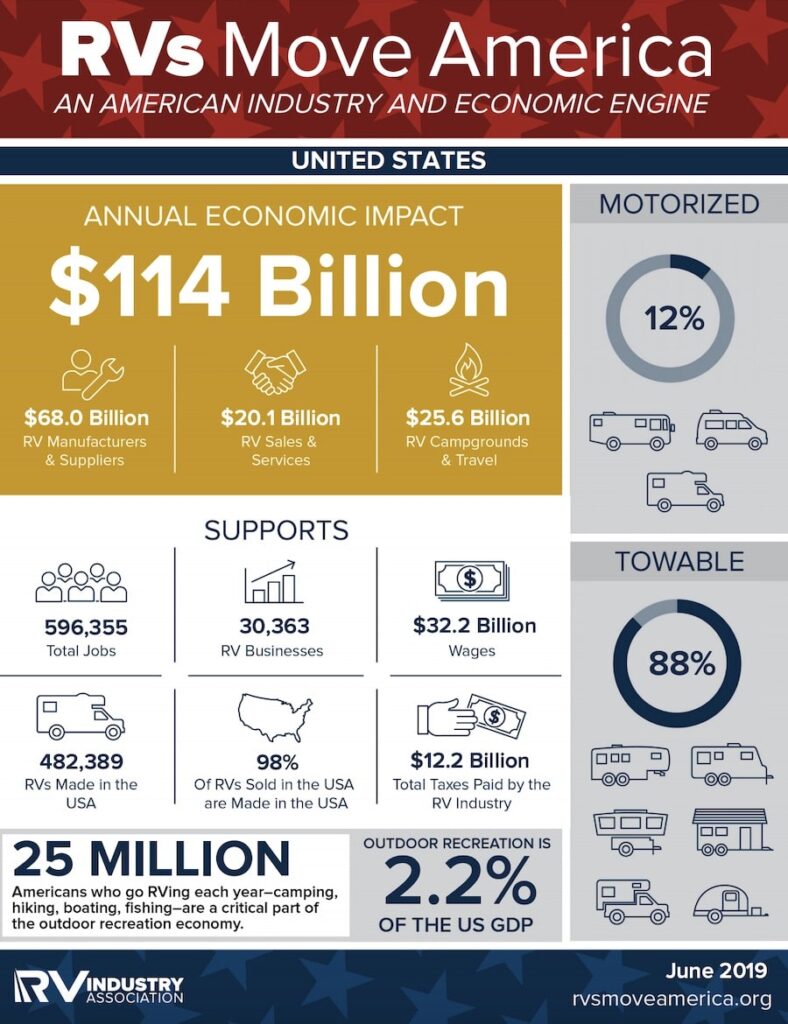Thanks for your support! If you make a purchase using our links in this article, we may make a commission. And, as an Amazon Associate, I earn from qualifying purchases. See the full disclosure here.
RV camping is gaining in popularity all across the US and Canada among all age groups. Every year more and more households own an RV or rent recreational vehicles as a means to camp and enjoy nature.
So we wanted to put together our list of the key statistics, trends, data and analysis from RV manufacturers, the RV Industry Association, Industry Reports, RV owners and campers in general to study the growth of the RV camping industry in North America.
RV Camping Consumer Demographic Data
1. In the last year, there has been an increase of one million new camper households. Since 2014 there has been an estimated increase of 7 million camper households that consider themselves annual campers.
2. Since 2014, the percentage of campers that camp three or more times annually has increased by 72 percent. This comes after there was significant growth between 2014 and 2017 in the number of new camper households. This influx of new campers largely comes from an influx of younger and more diverse campers.
3. Half of all campers credit their love of the outdoors as the primary reason for their interest in camping. This reason has remained number one among camping enthusiasts for over five years of research.
4. The momentum of camping can also be attributed to the increase in camper’s self identifying as lifelong campers. Roughly one third of all campers now consider themselves to be lifelong campers. This is the highest it has ever been in the history of the report. It should also be noted that younger campers such as millennials (ages 22 to 37), and Gen Xers (ages 38-53) are more likely to identify themselves as lifelong campers than in previous years.
5. 50 percent of millennials say life events enable them to camp more often. These life events include things like having children and getting an increase in income. Camping families with campers that are under the age of 18 have also been found to be the most devoted group of campers. With children in the household there is extra motivation to own camping gear whether its something small like a tent, or something larger like an RV.
6. For the first time in this report’s history, in 2018 the percentage of new campers from multicultural groups outpaced the percentage of new Caucasian campers. New campers remain more diverse than the actual population of the United States. Hispanic campers exceed what would be expected in the overall population by six percent (22 percent vs 16 percent). Asian Americans represent at a rate that is three times higher than their percentage in the United States population.
7. Glamping and van life were not included in the 2019 North American Camping Report until recent years because it was not considered a camping category at the time. However, now more than half of all campers surveyed have expressed interest in glamping sometime in the next year.
What Kind of RVs are People Buying?
8. RV ownership has increased over the rates of borrowing or renting in recent years. RV manufacturers have developed a multitude of RV types such as motorhomes, campervans, travel trailers, 5th wheels, truck campers, and popup campers also known as, folding camp trailers. Additionally, interest in luxury cabins has increased. 61 percent of RVers have indicated that they own the RV that they use the most. Campers of all ages have expressed interest in having a luxury cabin experience.
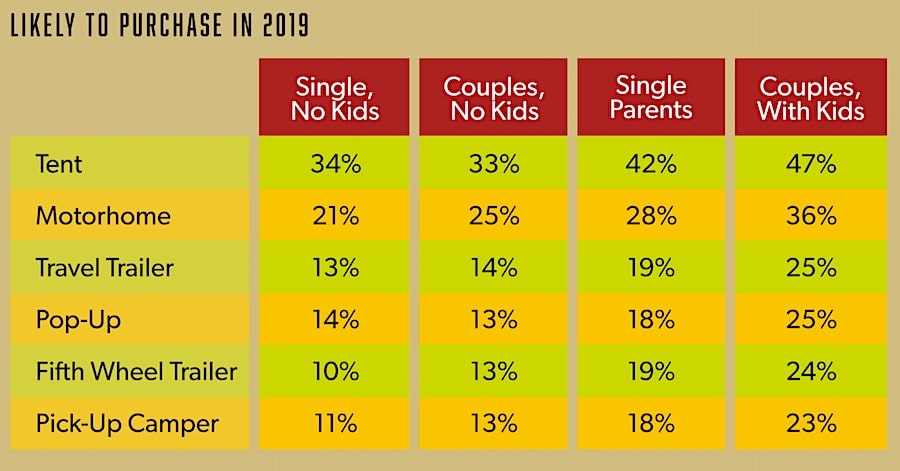
9. Canadian campers appear to be more satisfied with their camping experience that their counterparts in the United States. 64 percent of Canadian campers have the expressed interest in RV ownership. This rate is higher than that in the United States. However, despite those high numbers, 46 percent of Canadian campers still expressed interest in a glamping experience.
10. The number of United States camping households rose to 78,800,000 in 2018. This was an increase of 1.4 million from the previous year.
11. Frequency of camping has also increased in recent years. The number of camping households that camp at least once a year has increased by 22 percent since 2014. However, it is even more impressive how much the percentage of campers who camp three or more times a year has increased. That number has increased by 72 percent since 2014. This can largely be attributed to the increase in the number of camping households and the increased propensity to camp more times each year.
12. Roughly one third of all campers identify as lifelong campers. This includes 32 percent of millennials and 38 percent of Gen Xers. Additionally, 90 percent of teen campers say that the plan to continue camping as adults. 21 percent of Asian and 34 percent of black campers are more likely to identify as lifelong campers.
13. There has also been a significant increase in new campers in recent years. Roughly five percent of camping households have stated that their first camping experience came in 2018 or later.
Why Do People Go Camping?
14. 46 percent of prospective campers have said that the main reason for their interest in camping is a desire to spend more time outdoors after spending so much time inside. 41 percent say that it is a more affordable way to travel, and 29 percent believe that it will help them reconnect with friends or family. Other major reasons include, feeling safer while camping, being able to disconnect from technology, not needing to travel as far to camp, not wanting to fly, and not being comfortable with other forms of travel.
15. Since 2019, more people have expressed interest in camping with fewer people. 31 percent plan to camp with just two people. 36 percent plan on camping with three to five people.
16. People have also expressed interest in camping closer to home. Roughly 70 percent of camper’s plan to camp closer to home than they have in recent years. 68 percent say that they are more willing to travel to travel to less popular locations in order to avoid locations that can get overcrowded like national parks.
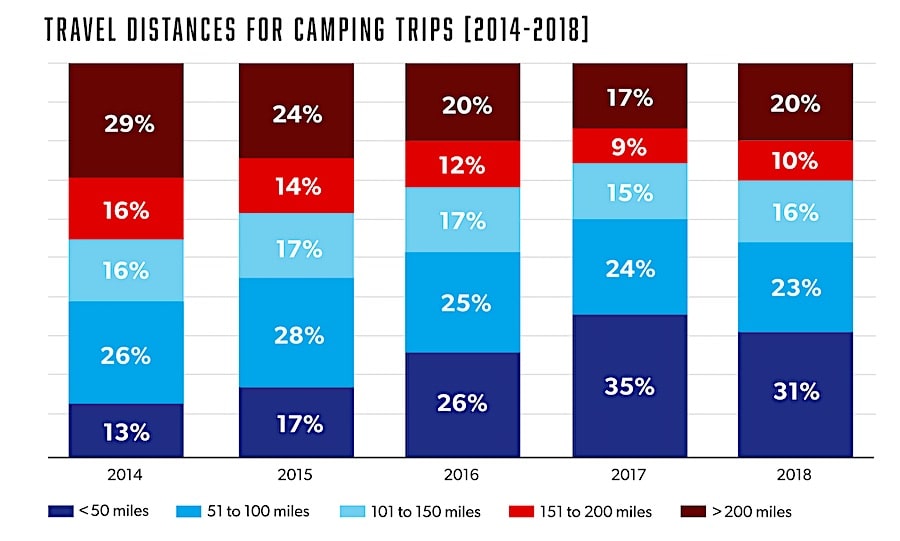
17. There is also an increased interest in trying different types of camping. However, prospective campers are less certain in which type of experience they are interest in trying. 1 in 3 are interested in trying glamping.
18. Campers have expressed an increased interest in having a private bathroom. 63 percent of current campers and 44 percent of prospective campers list having a private bathroom as a major priority for them. Roughly half of prospective campers say that the availability of private bathrooms will influence where they stay.
19. Depending on several factors, 38 percent of campers could extend their camping seasons, or they could camp more often. This number is increased to 45 percent if they have children in the household.
20. More than ever, travelers recognize the importance of kids spending time outdoors. 60 percent of travelers feel that it is more important than ever for children to spend time outdoors. 31 percent have always felt this way. Of travelers that have indicated an interest in taking their children camping for the first time, 67 percent say their experiences have increased the importance they place on children spending time outdoors.
21. Once campers get to go camping again, 69 percent have expressed an interest in exploring, 67 percent want to relax, and 66 percent want to clear their mind.
22. The most popular reason travelers want to start traveling again is to spend time outdoors with their families. This is followed by getting to enjoy outdoor activities, traveling in general, and spending time outdoors with their kids.
23. Older generations still make up a large percentage of new campers as 44 percent of new campers are 40 years or older. However, there has been an increase in new campers from younger generations over recent years.
24. Previously, camping was not very ethnically diverse. However, since the ethnic mix of campers was first measured in 2012, the percentage of non-white camping households has increased from 12 percent to 29 percent. 2018 was the first time that non-white campers (51 percent) outpaced white campers (49 percent).
Socio-Economic RV Camper Data
25. Most campers tend to fall into the middle income category. 28 percent of campers have an annual income between $25,000 and $49,999. 21 percent have an income from $50,000 to $74,999.
26. As in recent years, the majority of camping households include minor children. As the overall demographic of camping families continues to trend younger, it can be expected the number of camping households with children will continue to increase. Additionally, the percentage of families with children in the household has increased by 17 percent over the past 5 years.
27. The percentage of same-sex camping households remained stable at 8 percent. However, this is still an increase from what it was in 2015 (5 percent). This is also 7 percent higher than the United States general population figures. The percentage of same-sex camping households camping with children also remained stable. It is slightly below the percentage of all other households that camp with children. However, this is only by a few percentage points.
28. Teens are the future of camping, and they have expressed strong opinions when it comes to camping. Roughly 96 percent of teen campers say they enjoy their time camping with family and friends. They also recognize that camping leads to a healthier lifestyle.
29. 97 percent of teen campers say that camping relaxes the adults. 96 percent enjoy camping with friends and family. 94 percent believe it is important for young people to spend time outdoors. 93 percent are enthusiastic about camping. 91 percent would like to take their children camping someday. 89 percent plan to continue camping as an adult.
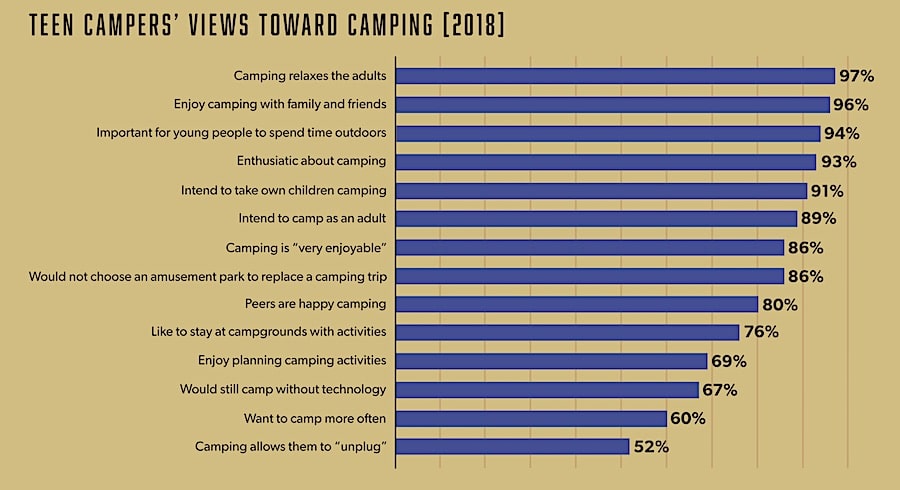
30. Young campers have listed fishing (73 percent) and hiking (60 percent) as their favorite activities while camping. 40 percent list biking as their favorite, 42 percent list sightseeing, and 33 percent say canoeing is their favorite. All of these activities have remained high on the list of popular activities for the past three years.
31. Surprisingly, the importance of internet access while camping has actually decreased among teen campers in recent years. The percentage has gone from 37percent to 29 percent. However, 80 percent of teen campers still say that they go online at least one time a day while they are camping. Nearly half go online four or more times a day. Two thirds of teen campers say they would still want to go camping if they could not go online at all.
32. Since 2014, the percentage of Hispanic camping households has increased by 5 percent. Hispanic households currently represent 11 percent of all camping households in the United States. They are the largest non-white group of campers. They are also the fastest growing group of campers based on ethnicity.
33. Since campers have shown a propensity for more, shorter duration trips in recent years, it makes sense that they stay closer to home compared to recent years. 54 percent of campers travel less than 100 miles from home to camp. Millennials and Gen X campers are the groups most likely to camp closer to home. Conversely, Asian campers tend to travel the furthest to camp, with more than half traveling more than 100 miles for their trips.
How Often Do People Go RV Camping?
34. While people tend to travel less far to camp these days, they tend to camp more often as a result. Younger campers especially are more likely than ever to plan more weekend trips or extend the length of their vacations.
35. Since 2018, 44 percent of campers have not changed their camping habits. However, 19 percent include more weekend days, 17 percent include more weekdays, 16 percent were longer than in the past, and 15 percent were shorter than in the past.
36. As more families adopt the camping lifestyle, there is an emerging trend that shows more campers are spending time on public and private lands. This is opposed to staying at a designated campground.
37. Campers continue to show a reliance on public lands for their camping trips. Roughly 60 percent of camper nights are spent on public lands or in public campgrounds.
38. 40 percent of campers say that the type of campground site and the quality of the site have a significant impact on their selection of campgrounds. Furthermore, 25 percent of campers mentioned the campground atmosphere as a significant factor. However, older campers are not very likely to care about the atmosphere.
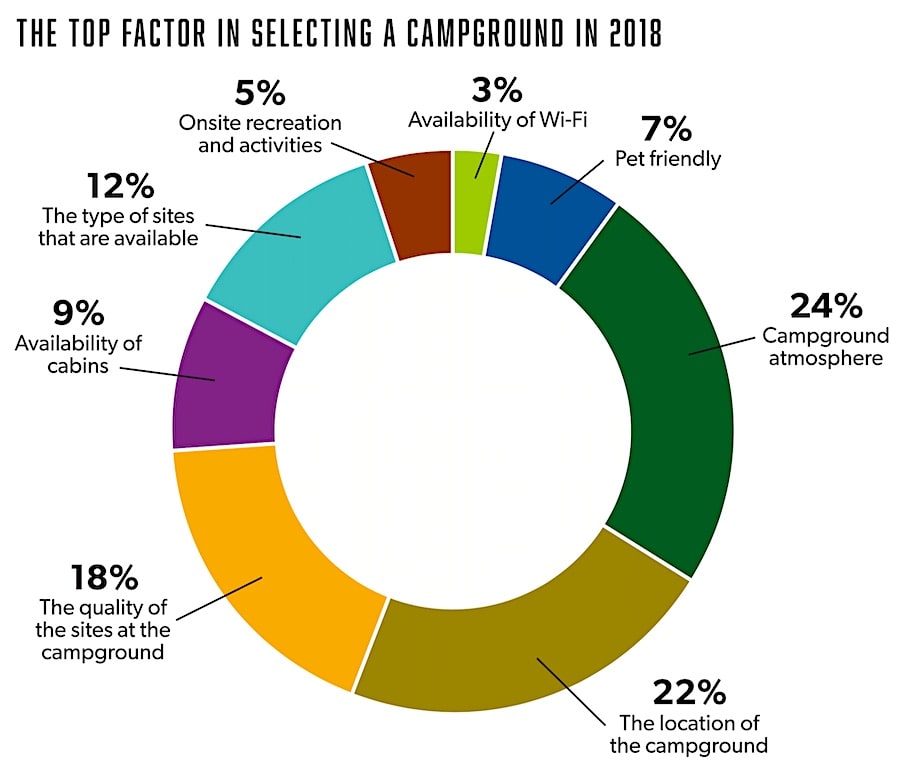
39. Additionally, 9 percent of campers are influenced by the availability of cabins. 7 percent require the campground to be pet friendly to stay at a campsite. 5 percent value the availability of onsite recreation and activities. Finally, three percent are influenced by the availability of Wi-Fi.
40. Nearly all campers, roughly 90 percent, say they leave the campground to participate in other activities. These activities include sightseeing, dining, or other outdoor recreational activities. There is also an increased interest in combing camping with a musical event. This has increased from 9 to 19 percent in recent years.
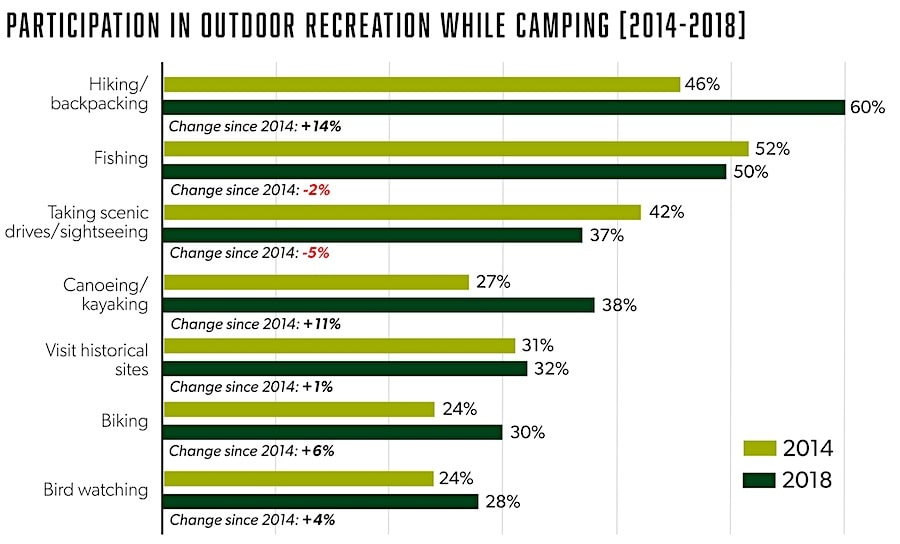
41. Currently, 59 percent of campers list a tent as their primary accommodations. 24 percent list an RV as their primary accommodation, and 16 percent list a cabin. 1 percent list something other than those three major accommodations.
42. Younger campers tend to identify more closely with their generation than with their ethnicity. They also tend to camp in larger social groups, forming their own camping families that may include friends, siblings, and parents. Conversely, older campers are more likely to camp with a spouse. Hispanic campers tend to camp with siblings and parents.
43. Multi-generational camping is also increasing over time. Roughly 60 percent of camping households have reported taking trips with multiple generations. This is up from 56 percent in 2015. Hispanic campers are the most like to camp with multiple generations, with 74 percent saying they do.
44. As the large bubble of new campers settles into their preferred camping lifestyle, the experimentation with different accommodations is decreasing. 47 percent of campers indicate that they tried a new accommodation in 2018. Although this is still quite high, it is actually a decrease from 55 percent in 2017.
45. An overall love for the outdoors is listed as the driving force for North Americans to get outside and camp. 50 percent of younger campers list family influence as the primary reason for their interest in camping. 60 percent of older campers say that their love of the outdoors is their primary reason to go camping.
46. Overall, campers are increasingly using camping as a way to get more active. This applies to all generations and ethnic groups. Campers view camping as a way to escape the stresses of regular life, and as a way to relax and decompress.
47. Interestingly, the Canadian camping market appears to be more stable than the market in the United States. Canadian campers are more satisfied with their camping experiences are far less likely to seek new accommodations or experiences. However, there is some change in the type of accommodations they use. The use of tents has dropped from 60 percent to 51 percent, and RV ownership has increased from 22 percent to 30 percent.
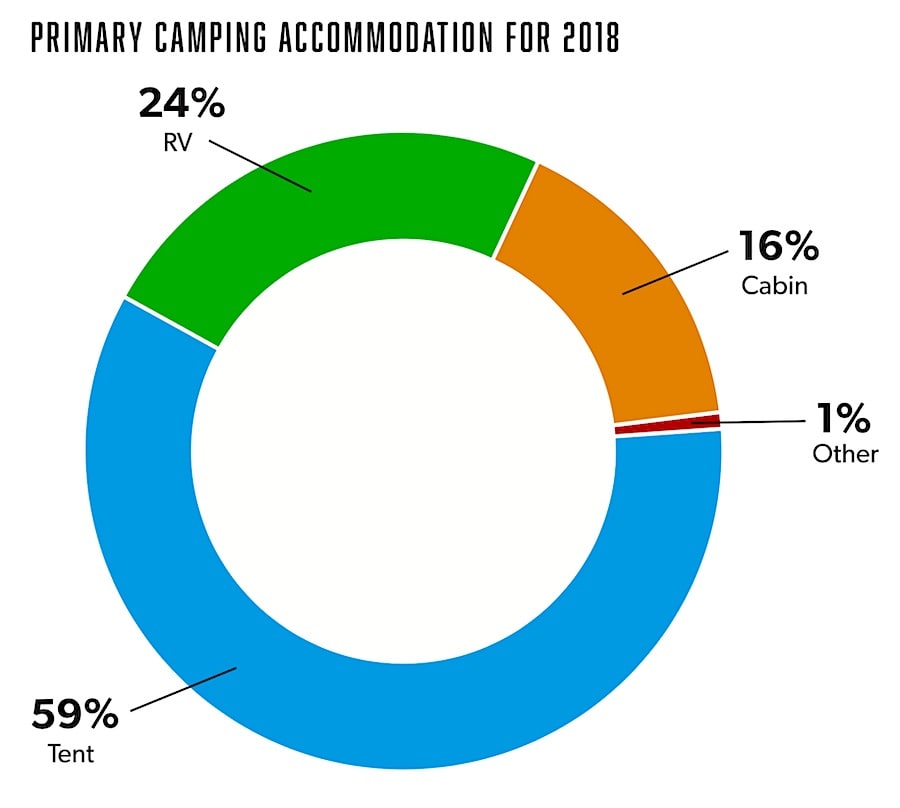
48. Glamping is one of the newest forms of camping, and as a result, it has increased in popularity. 45 percent of campers have shown an interest in glamping. You should note that it does not matter what age we are talking about; glamping is popular among people of all ages. However, interest has increased significantly among Asian camping households. It has risen by 36 percent since 2017.
49. Van life has also emerged in popularity over recent years. It is especially popular among black campers, rising from 12 to 22 percent recently.
50. The life events that cause each generation to take an interest in camping are different. The primary reason for millennials to start camping is having kids (30 percent). This is followed by seeing popular destinations others are going to (30 percent) and getting an increase in income (27 percent). The primary reason for Generation Xers to start camping is seeing popular destinations others are going to (27 percent), followed by their kids getting older (24 percent), and having kids (22 percent). Baby boomers primarily start camping after retirement (37 percent), followed by seeing popular destinations others are going to (24 percent) and followed by physical limitations (22 percent). Retirement affects mature campers the most (37 percent). They are then influenced by physical limitations (28 percent), and not wanting to try new accommodations (26 percent).
RV Industry Trends and Analysis
According to the findings in the North American Camping Report conducted each year by KOA, the RV and camping industry is one of the fastest growing industries in the United States and Canada and it has a huge economic impact on the economies of both countries.
While wholesale shipments of RVs reach sales figures in the billions of dollars, benefitting huge RV manufacturers like Thor Industries, the prospective RV owner has more choices than ever in the ever changing competitive landscape of the RV industry.
In 2020 many states RV parks and campgrounds are booked solid.
Younger generations are increasingly becoming interested in camping, especially after they have children. There has also been an increase in people of non-white ethnicities entering the world of RVs and camping.
As new types of accommodations become available, more and more people find something that interests them in the world of camping. In recent years, more people have gained a desire to spend time outside as they seek to get away from technology. That is expected to increase over the next few years as young people look for ways to escape everyday life.
Are you someone who has started RVing or camping in recent years? Are you from a younger generation, or did you start camping later in life? What accommodations do you prefer when camping? Let us know in the comments!


